There are several ways you can wire multiple speakers. One of the most commonly used methods is wiring speakers in parallel. Another common option is wiring speakers in series. In some instances, you can combine series and parallel speaker wiring depending on your needs.
It is important to run speakers correctly depending on the number of speakers being connected and the specifications of the amp. By wiring multiple speakers correctly, you will enjoy the best possible sound quality. Also, you will protect your audio equipment from damage that results from improper speaker wiring. In this article, we will discuss parallel speaker wiring in detail.
Why Consider Running Speakers in Parallel?
Essentially, the impedance rating of the amplifier to which you want to wire your speakers largely determines whether you will wire them in parallel or series. But what is impedance? Why does impedance matter? Impedance is a term that refers to the load that a speaker has on the amplifier it is connected to. In other words, it is the resistance that the speaker has to the current passing through it from the amp.
The most important thing to consider is to ensure you do not overload your amplifier. For instance, if your amp has an impedance rating of 4 ohms, connect the speakers in such a way that the overall load of the speakers does not go below 4 ohms.
If the total load goes below the impedance rating of the amplifier, it means that the speakers will draw more power than what the amp can safely provide. Consequently, there may be distortion or damage to the amplifier.
When connecting multiple speakers in parallel, you combine all negative (-) terminals together and all positive (+) terminals together. You can achieve this by either connecting all the speakers together, then connect them to the amp, or connect all corresponding terminals to the amplifier.
Read related article: Best 5×7 speakers.
Speakers in Parallel Calculator
Wiring speakers in parallel reduces their total impedance load on the amp. To calculate the total impedance of multiple speakers connected in parallel, you divide the total number of speakers you are connecting by their impedance. A simple speakers in parallel calculator is as follows:
[table id=14 /]
With the above speakers in parallel calculator, you can be able to calculate the load that your speakers will have on your amplifier. So why consider running speakers in parallel? The answer to this question is that you should wire speakers in parallel when hooking multiple speakers to an amplifier with a lower impedance rating than the speakers.
For instance, if you are hooking 2 8 ohm speakers in parallel to an amplifier that is rated 4 ohms, you should connect them in parallel to get a total load of 4 ohms. Thus, keep the above speakers in parallel calculator in mind to get the impedance right. If you make a mistake and hook them in series, you will double the load to 8 ohms (4+4 ohms), which will overload the 4-ohm amplifier.
Read related article: Best double din head units.
2 4 Ohm Speakers in Parallel
When wiring two 4 ohm speakers in parallel, you will get a total load of 2 ohms. Here is a parallel speaker wiring diagram for this connection:
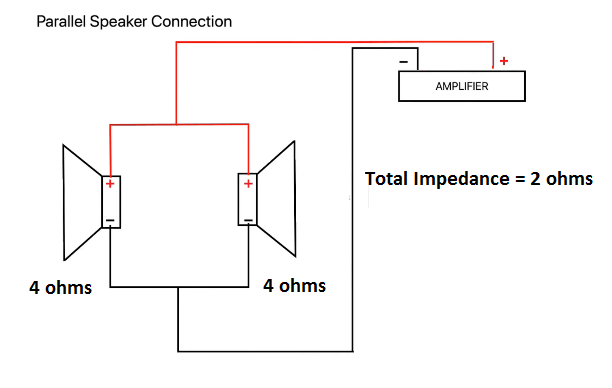 4 4 Ohm Speakers in Parallel
4 4 Ohm Speakers in Parallel
When wiring four 4 ohm speakers in parallel, you will get a total load of 1 ohms. Here is a parallel speaker wiring diagram for this connection: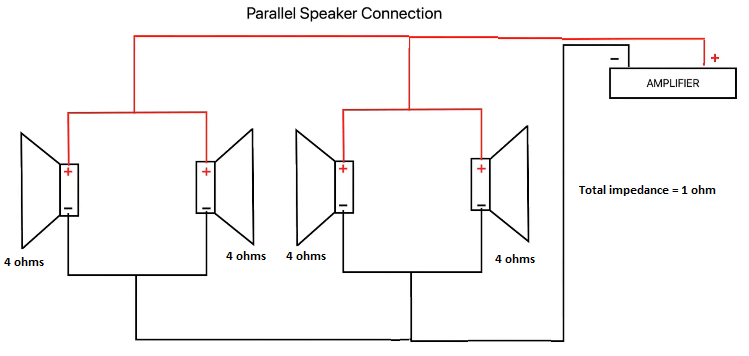
3 8 Ohm Speakers in Parallel
When connecting three 8 ohm speakers in parallel, you will get a total load of 2.67 ohms. Here is a parallel speaker wiring diagram for this connection:
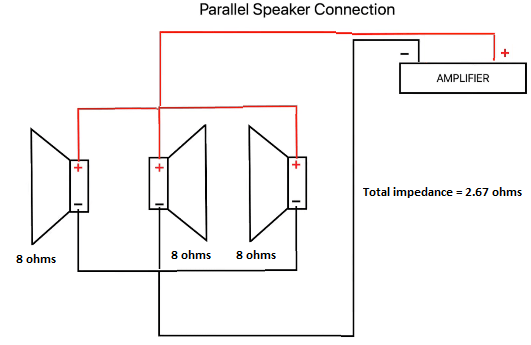
4 8 Ohm Speakers in Parallel
When connecting four 8 ohm speakers in parallel, you will get a total load of 2 ohms. With this connection, ensure your amp can drive a 2 ohm load when bridged. Here is a parallel speaker wiring diagram for this connection:

6 8 Ohm Speakers in Parallel
When running six 8 ohm speakers in parallel, you will get a total load of 1.33 ohms. However, this connection is not advisable since most amps are rated 4 ohms on the minimum. Also, most amps cannot drive a load of below 2 ohms when bridged. Regardless, here is a parallel speaker wiring diagram for running 6 8 ohm speakers in parallel:
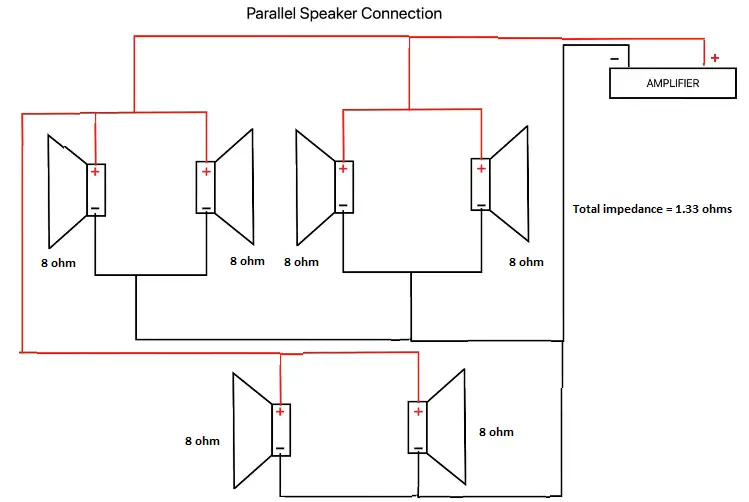
2 16 Ohm Speakers in Parallel
When running two 16 ohm speakers in parallel, you will get a total load of 8 ohms. Here is a parallel speaker wiring diagram for this connection:
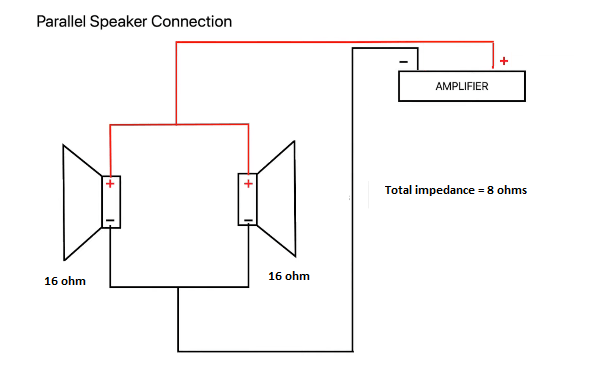
Precaution When Running Speakers in Parallel
When wiring multiple speakers in parallel, their total load on the amp is divided. Thus, you must take care to ensure that the total ohms load is either equal to or greater than the minimum load required for the amplifier. Else, you risk damaging your equipment. That is why you should invest in a high-performance amplifier such as the Skar Audio RP-1200.1D for enhanced reliability.
Pros of Wiring Speakers in Parallel
There are several advantages of running multiple speakers in a parallel connection including:
- Best for more power and volume
- If one speaker fails, other speakers in the parallel connection will still work
- In most cases, it offers superior sound quality
Cons of Connecting Speakers in Parallel
Unfortunately, connecting multiple speakers in parallel comes with some disadvantages including:
- You may need an amplifier with multiple channels
- It is often challenging to add more speakers
- Sometimes, it is not possible to hook speakers in series due to minimum ohm requirements
Why do Speakers Connected in Parallel Sound Better than in Series?
With parallel speaker wiring, each and every crossover in the speaker system only notices the resistance of a single speaker. Consequently, you get better sound quality since each connected speaker maintains its sound quality.
On the other hand, wiring speakers in series means that each crossover will see the resistance of all other speakers. As a result, the sound output in series is affected negatively since each speaker can produce odd sounds from low quality speakers in the connection.
Conclusion
Wiring speakers in parallel is simple, although adding extra speakers into the connection tends to be tedious. Regardless, parallel speaker connections offer great sound quality. Just ensure the total load does not go below the minimum ohms rating of the amplifier.
Check related article: Top rated 5.25 speakers.

Kenny Owen is an acclaimed audio expert and longtime enthusiast with a deep passion for sound technology. With over 15 years of experience in the car and home audio industry, Kenny has established himself as a trusted authority on everything from speaker setups and amplifier configurations to the latest audio equipment and innovations.
Through his engaging writing style and meticulously researched articles, Kenny shares his vast knowledge on optimizing audio systems for superior sound quality. He provides in-depth tips and tricks for achieving the best listening experience, whether it’s tuning a car’s audio system for an immersive musical journey or creating a high-fidelity home theater setup. Additionally, Kenny’s comprehensive buying guides empower readers to make informed decisions when investing in audio components, ensuring they get the most bang for their buck.

Kenny Owen is an acclaimed audio expert and longtime enthusiast with a deep passion for sound technology. With over 15 years of experience in the car and home audio industry, Kenny has established himself as a trusted authority on everything from speaker setups and amplifier configurations to the latest audio equipment and innovations.
Through his engaging writing style and meticulously researched articles, Kenny shares his vast knowledge on optimizing audio systems for superior sound quality. He provides in-depth tips and tricks for achieving the best listening experience, whether it’s tuning a car’s audio system for an immersive musical journey or creating a high-fidelity home theater setup. Additionally, Kenny’s comprehensive buying guides empower readers to make informed decisions when investing in audio components, ensuring they get the most bang for their buck.

